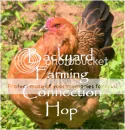During the weekly genetic mini-series, we have discussed the basics of genetic inheritance in chickens. We first discussed egg color, introducing the idea of basic autosomal dominance (simple dominant and recessive) during our discussion of blue egg color. We then approached incomplete dominance as seen in blue feathering. After reviewing the basic mechanics of DNA and chromosomes, we played with the idea of sex-linkage in chickens as a result of the female being hemizygous for the Z sex chromosome which carries silver, barring, rate of feathering, and dermal melanin (also chocolate; see here.) Within these topics, we have covered the mechanisms by which all traits in chickens are inherited. Now we can simply keep these mechanisms in mind as we play with chicken colors and forms.
Plumage Pigments
Genetics Mini-Series Article #7
The best article on chicken plumage is hands-down the “Basics” of chicken color on the kippenjungle/Chicken Quest site. The more time you spend exploring his website, the more you will find like this list of chicken genes or pictures of cool, instructive breeding projects. That said, I’ll summarize and simplify here.
There are two basic pigments made by animals, including birds: eumelanin, a black pigment, and phenomelanin, a red pigment. Both are forms of melanin. You see eumelanin everywhere. It is the pigment that darkens our skin to protect us from ultraviolet radiation, the fur of our dogs and cats, and the black and blues we see in chicken feathers. Phenomelanin colors our freckles, the tawny yellow of lion’s fur, and the red and gold of plumage. Both of these pigments can be inhibited to create lighter greys and browns (eumelanin), buff or blonde (phenomelanin), or even white.
Other colors we see in birds and animals (also here) are created in two main ways: pigments derived from the food they eat and colors created by the play of light through structural patterns in feathers. We all know that flamingos get their fantastic pink color from their diet: The carotenoids contained in the plant life (algae) eaten by shrimp are passed up the food chain to give flamingos a color they could not create themselves. The bright blue of an indigo bunting’s feathers is really just black eumelanin, but the structure of the feather causes the light to refract in such a way as to appear bright blue. A wild-type chicken (e+, often called duckwing) has a base or ground color of phenomelanin which you can see clearly in the salmon/reddish breast of the female. You can see the black of eumelanin in the breast and tail of the male. The genetics guru at the kippenjungle/Chicken Quest site (Henk69 on forum sites) explains:The wildtype chicken male and females have sexual dimorphic plumage color. The hen has to be camouflaged and therefor is more groundcolored than the male; she has delicate black patterning. Her neck is gold with black striping towards the shoulder, the breast is salmon colored, a kind of pheomelanin expression; the upperside is densely “stippled” on a yellow/brown background. The rooster has more bright groundcolor shades and has big black areas with green sheen on tail and wingbands. The breast is generally black; neck hackles, shoulder and saddle are red to gold. The wing triangle is golden brown in wildtype male.
Areas typically dominated by eumelain or phenomelanin can be extended. For example, the dominant trait E, or extended black, literally extends the area of eumelanin to make an entirely black bird. Buff birds are covered by an extended area of phenomelanin, diluted by inhibitors. (Interestingly, geneticists haven’t figured out what gene inhibits all of the eumelanin in a buff bird. The closest thing they know of is Colombian restriction, Co, which restricts or limits eumelanin to the hackles and tail.) Birchen (ER), wheaten (EWh), and partridge (Eb) are other patterns emphasizing (or restricting) areas of eumelanin and phenomelanin.
![By Ernst Vikne (Little hen) [CC-BY-SA-2.0 (http://creativecommons.org/licenses/by-sa/2.0)], via Wikimedia Commons](https://i0.wp.com/upload.wikimedia.org/wikipedia/commons/d/da/Norwegian_hen.jpg)
This Norwegian Jaerhone has a variety of warm colors resulting from differing concentrations of phenomelanin and some areas of eumelanin.
![By Daniel Powell (Daniel Powell) [CC-BY-SA-3.0 (http://creativecommons.org/licenses/by-sa/3.0)], via Wikimedia Commons](https://i0.wp.com/upload.wikimedia.org/wikipedia/commons/a/ad/Citron_spangled_maiden_rock_hen.jpg)
Artistry in genetics: Enhancers and inhibitors at play in One Earth Farm’s citron spangled Maiden Rock hen
Shared with:
![By നവനീത് കൃഷ്ണന്. എസ് (സ്വന്തം സൃഷ്ടി) [GFDL (http://www.gnu.org/copyleft/fdl.html) or CC-BY-SA-3.0-2.5-2.0-1.0 (http://creativecommons.org/licenses/by-sa/3.0)], via Wikimedia Commons](https://i0.wp.com/upload.wikimedia.org/wikipedia/commons/1/18/Peafowl-closeup-feather.jpg)
![By B_cool from SIN, Singapore (originally posted to Flickr as Tiger in the water) [CC-BY-2.0 (http://creativecommons.org/licenses/by/2.0)], via Wikimedia Commons](https://i0.wp.com/upload.wikimedia.org/wikipedia/commons/a/a4/Tiger_in_the_water.jpg)
![By Kevin BoltonKevin Bolton [CC-BY-2.0 (http://creativecommons.org/licenses/by/2.0) or CC-BY-2.0 (http://creativecommons.org/licenses/by/2.0)], via Wikimedia Commons](https://i0.wp.com/upload.wikimedia.org/wikipedia/commons/f/fe/IndigoBuntingonPlant.jpg)
![By Lip Kee Yap [CC-BY-SA-2.0 (http://creativecommons.org/licenses/by-sa/2.0)], via Wikimedia Commons](https://i0.wp.com/upload.wikimedia.org/wikipedia/commons/f/f9/Gallus_gallus_-Kaziranga_National_Park%2C_Assam%2C_India-8.jpg)
![By Žiga (Own work) [CC-BY-SA-3.0 (http://creativecommons.org/licenses/by-sa/3.0) or GFDL (http://www.gnu.org/copyleft/fdl.html)], via Wikimedia Commons](https://i0.wp.com/upload.wikimedia.org/wikipedia/commons/1/1b/Rooster-1.jpg)
![By Mark Robinson from Williton, UK (Silver Sebright) [CC-BY-2.0 (http://creativecommons.org/licenses/by/2.0)], via Wikimedia Commons](https://i0.wp.com/upload.wikimedia.org/wikipedia/commons/0/02/Silver_Sebright_hen.jpg)








Beautiful birds . . .
Pingback: Birds from the National Aviary « Scratch Cradle
Pingback: GMS Supplement #1: Recessive White « Scratch Cradle
I love the info. Beautiful birds!
We just finished our coop. Check it out.
http://choresandchandeliers.blogspot.com/2012/10/yes-i-have-wreath-on-my-chicken-coop.html
I can’t wait to fill it with chickens!!!
I absolutely did check it out. Adorable! It looks like you have a handsome fellow and a couple of hens in there. Love the goat! If you want some tips on getting started with backyard chickens, you can check out my recent post. Best wishes!
Heather
I love that last hen! Gorgeous! (Okay, I’ll settle down now!)
Completely agreed! Definitely check out One Earth Farms. Their breeding projects are so educational and inspiring. It’s high art in genetics!
Great Photos! I have a red jungle fowl rooster and hen and she is such an “ugly” bird (sorry to say that) compared to how beautiful he is. Great blog!!
That is so often the case with wild birds, isn’t it? The momma has to be plain and unassuming to keep her chicks safe when sitting on the nest. I remember noting the difference when I was a girl and marveling that, in birds, it is the male who has to wear the dress and make-up. 🙂 Silly, but in some ways true.